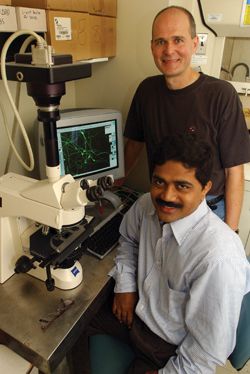
Bruce Carter, Ph.D., and Rajappa Kenchappa, Ph.D., are studying a signaling mechanism that initiates cell death.
Photo by Dana Johnson
Multifunctional receptor sends ‘life or death’ signals
Our brains start dying before we are even born.
During normal development of the vertebrate nervous system, more nerve cells (neurons) are produced than we will ever need or use. About half of those unnecessary neurons die through a pre-programmed “suicide” mechanism called apoptosis.
Scientists now have another clue as to how this suicide is regulated in neurons.
In a recent issue of Neuron, Bruce Carter, Ph.D., and colleagues detail a signaling mechanism that initiates cell death in neurons.
Not only are these findings important to understanding normal development of the nervous system, but knowing these signals could reveal ways to stop brain cell death resulting from injury or disease.
In the developing nervous system, immature neural cells must be “convinced” to stay alive. Neurotrophins, a family of proteins that includes nerve growth factor (NGF), are the coercive protein molecules that instruct neurons to not kill themselves.
The neurotrophins can bind to two different classes of neurotrophin receptors embedded within the neuronal membrane. Neurotrophin binding to the Trk family of receptors usually promotes survival.
Ironically, neurotrophin binding to another type of receptor — the p75 receptor — can promote either cell survival or cell death.
“One of the major stumbling blocks in this area is the idea that p75 would cause cell death,” said Carter, associate professor of Biochemistry. “When that was discovered, it was already known for 50 years that NGF promotes survival. So the idea that the receptor for NGF would cause cell death didn't really make sense.”
Carter's lab has been trying to understand how these conflicting signals are generated by p75. Several years ago, they identified a protein bound to the intracellular piece of the p75 receptor. This protein, called NRIF (neurotrophin receptor interacting factor), resembled well-known transcription factors that alter gene expression within the nucleus. They and others had also determined that NRIF entry into the nucleus induced apoptotic cell death.
“It was kind of puzzling that we found a putative transcription factor 'out there' at the cell surface of the neuron (instead of in the nucleus),” Carter said.
But for NRIF to perform the function of an apoptosis-inducing transcription factor, it must be somehow liberated from the cell surface and transported to the nucleus. Carter and research instructor Rajappa Kenchappa, Ph.D., wanted to chart the course of this 'death signal.'
A clue came when another group showed that p75 could be cleaved by gamma-secretase, the enzyme implicated in amyloid plaque formation in Alzheimer's disease. But this group had been unable to show that neurotrophins, the natural ligands (or binding partners) for the p75 receptor, initiated this cleavage.
Kenchappa set up experiments to see if this cleavage could be induced in neurons by neurotrophins. Generally, the cleavage happens within a few hours of adding the necessary ligand to the cells. But Kenchappa was not seeing any cleavage induced by the neurotrophins.
It turned out that timing was everything. Since it was the Christmas holiday, Kenchappa went home to spend time with his family. He let the cells linger for several hours longer than he should have. But that delay in collecting his cells proved crucial — the cleavage happened, but it took nearly 12 hours.
With the cleavage of p75 confirmed, Carter and Kenchappa wanted to see if this cleavage caused NRIF to enter the nucleus as they had suspected.
To test this, the researchers treated cultured neurons with compounds that inhibit gamma-secretase cleavage. They then added neurotrophin to the mix. They found that gamma-secretase inhibition prevented NRIF from entering the nucleus and completely blocked cell death.
The researchers confirmed these findings in an animal model using neurons from newborn rats. These neurons, which naturally undergo apoptosis in the early postnatal period, showed the same pattern of NRIF translocation to the nucleus.
The findings fill in a previously unknown step in the cell death pathway and demonstrate a key role for p75 and NRIF in the natural neuronal death during development. Knowing these 'death signals' could allow researchers to develop therapies that prevent the undesirable cell death that occurs in neurodegenerative diseases like Alzheimer's and Parkinson's as well as after spinal cord injury and stroke.
Researchers from New York University, McGill University and Weill Medical College of Cornell University also contributed to the study. This research was supported by grants from the Canadian Institutes of Health Research and the National Institutes of Health.













